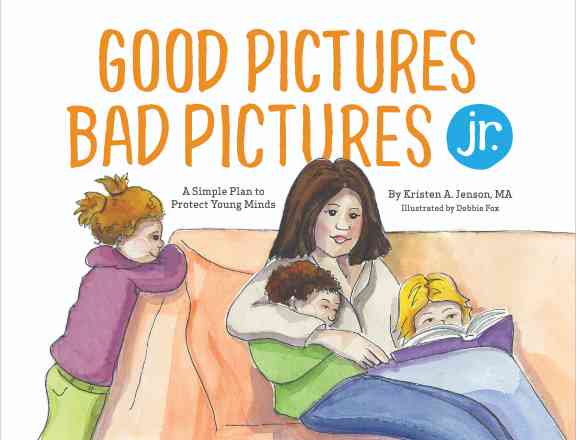

5 Ways to Teach Kids to Say NO! to Porn with Assertive Communication Skills
Do you remember a time when you didn’t know how to speak up for yourself? Maybe you had a childhood experience like one mom who didn’t know what to say when her cousins showed her some risque magazines from under their parent’s bed. That’s why kids need assertive communication skills!

What if I told you that teaching your kids assertive communication skills will help them say no to porn? It’s easier than you think!
Keep reading to learn how kids can learn specific skills like I-statements that will prepare them to speak up for themselves.
What is assertive communication?
Communication can be broken down into (at least) three different styles: passive, aggressive, and assertive. When you speak passively, you may not say exactly how you feel because you want to please others. When you speak aggressively, you may overpower a conversation and say exactly what is on your mind, without thinking about the needs of those around you.
Assertive communication is a nice balance between passive and aggressive. Assertiveness is “the ability to speak up for ourselves in a way that is honest and respectful.”
Being assertive sounds like, “I feel uneasy when I see previews for those kinds of movies, so I’ve decided not to watch them. What other shows do you have?”
Assertive communication skills go hand in hand with setting boundaries, or communicating the things you need in order to feel safe. When children learn how to speak up for themselves in a respectful way, they feel more confident and secure.
Assertive communication does not come easily to everyone, but it can be learned through practice. Some kids (and adults) find it very hard to say no. You may be chuckling because you’ve heard the word “no” twenty times today! But refusing to clean your room and refusing to watch a video when all your friends are gathered around are two different stories.
How is being assertive going to help my child say no to porn?
Sometimes, kids are exposed to pornography by other children. GuardChild reports that:
- 29% of unwanted exposure to sexual materials occurred when children were online with their friends.
- 38% of teen girls and 39% of teen boys say they have had sexually suggestive text messages or emails shared with them that were originally meant for someone else.
Younger children are not protected from this either. If there is a cell phone or computer around, there is a chance for exposure to pornography.
While you may have certain rules and filters at your house, this may not be the case away from home. Have you practiced with your child what to say to a friend when they come across pornography together?
Your child may feel peer pressure to view porn because they want to be accepted by their friends and they worry they will be rejected if they don’t go along with other kids.
For example, how would your child respond to a friend at recess who shows them a bad picture on a cell phone? Let’s take a look at an assertive response:
Kathy comes over and says, “Susan, you’re not going to believe this picture of Joan.”
Susan sees the picture and thinks, Oh no, poor Joan!
Kathy laughs, “Isn’t this hilarious? Jace just texted it to me.”
Susan says, “No, it’s not funny. I feel uncomfortable looking at that picture. And I don’t think Joan would like us looking at it either. Let’s go tell a teacher.”
Notice how Susan spoke up for what she knew was right, without aggressively accusing Kathy.
Kids can use powerful refusal skills if they are taught what they are and when to use them. Using assertive communication skills, your child can encourage others to do things that are GOOD. Wouldn’t it be great if adults discussed positive peer pressure moments with kids just as often (or more) than the negative ones?
Even young kids can learn steps to take to be safe from exposure to pornography! Start the easy way with our read-aloud book for kids ages 3-7.
[[CTA]]
5 ways to strengthen assertive communication skills in your home
If you want your child to stand up to negative peer pressure, including situations involving pornography, they need a chance to develop assertive skills at home. It’s never too early to teach good communication skills! Here are five things you can start doing TODAY to help everyone in your home become more assertive:
- Get familiar with the three communication styles: assertive, passive, and aggressive. Ask yourself, which style am I regularly modeling for my children? Follow the tips in these articles if you want to improve your own assertiveness:
- The Mayo Clinic on Assertiveness
- Kidshealth.org on Assertiveness
- Help your child label their feelings from the very beginning. As children build their emotional vocabulary, they will be able to communicate better how they are honestly feeling when they are distressed.This might sound like, “Oh, Johnny, you tried three times to put your shoe on and it just won’t go on! You must be frustrated.”
- Teach preschool and elementary-aged children to communicate with an I-statement.“I feel ___________ when you _____________ . Please _____________.”For example, “I feel frustrated when you want me to hurry up but I can’t find my shoes. Please help me.”I-statements are one way to communicate honestly, directly, and respectfully without placing blame or judgment on others. This is assertive communication at its finest!
- Give your kids opportunities to practice speaking up for themselves! Deidre Parsons recommends ideas such as:
- Let your child order the food at a restaurant.
- Encourage kids to voice their opinion on current events at the dinner table.
- Coach your child on how to talk to their teacher about their grade on a test or a missing assignment.
- These little experiences will add up to give your child the confidence to deal with bigger issues in the future (like peer pressure to send nudes).
- Teach your children how to establish and respect boundaries. Coach Sarah recently shared helpful tips on setting boundaries. Kids can use I-statements to set a boundary when they are uncomfortable around someone:“I feel uncomfortable when you wrestle with me like that. Please stop.”It’s not easy to establish a boundary; in fact, it’s really hard to say this to a friend! But if our kids don’t learn how to honestly communicate their needs and values, they may end up being too passive when it really counts.
Practice assertive communication with your kids—ROLE PLAY!
Practice, practice, practice. Kids need a chance to practice what to say to someone when pornography shows up on a phone, in a movie, in a video game, or on a computer. Help them by role playing with them!
Have your children help come up with situations where they might need to speak out against pornography. Take turns being characters on different sides of the issue. Encourage your kids to use I-statements in the role play.
After the role play, discuss whether the response was too passive, too aggressive, or assertive (juuuust right!) How do you know? Here’s a quick checklist for assertive communication skills kids can use with a friend who is close to their age:
- I used a calm but firm voice.
- I made eye contact.
- I had good posture (square your shoulders).
- I used simple, clear words (like an I-statement).
- I suggested a better plan of action.
- I left the situation if my friend didn’t listen to me.
- I followed up by telling a trusted adult.
Be sure to talk about recognizing the difference between peers who are sharing something inappropriate and older “tricky people” who might want to harm them. Kids can practice how to respond to an adult (or even an older child) who is asking them to do something that doesn’t sound right or trick them.
In that case, getting away from the situation as fast as they can is the best plan! They need to know they are allowed to hit, scream and make a scene if needed. Yelling something like “Leave me alone! I don’t know you!” can grab other people’s attention so they can help.
Make sure, by the end of every role play, you have acted out at least one example of an assertive response. Also review any steps they may need to take later to follow up (which adult they would tell, etc.)
Examples of role play scenarios:
- You are assigned a partner for a school report. As the two of you are looking on the internet for information, something you searched for is blocked for inappropriate content. Your partner says he knows how to turn off the filter. What do you say next?
- You are playing at a friend’s house. You and your friend wander into the basement where her older sister and friends are watching inappropriate videos online. The teenagers yell at you to get out. You both run upstairs and your friend asks you not to say anything about it. What do you do next?
- You are driving in the car with mom and your cousin. Your cousin points out and laughs at a billboard that makes you feel uncomfortable. You can’t stop thinking about it after a few minutes. What do you say next?
Your kids can come up with ideas that fit with their own experiences. You might share some situations you faced as a child, too, and how you would respond now that you know all about I-statements!
As you follow the 5 ways to strengthen assertive communication skills in your home and practice by role-playing how to say NO to pornography, you are adding another layer of protection and prevention.
Think how great it will be to know your child has refusal skills and is prepared to say, “I feel uncomfortable seeing bad pictures. Let’s tell dad this came in the mail.”
Way to be a proactive parent! Do you have some thoughts about teaching kids to speak up? Join our community in our private Facebook group where you can share your ideas and questions with other parents.



Good Pictures Bad Pictures Jr.
“I highly recommend this book to all people with children. A must have for all parents!” —Amazon Review











